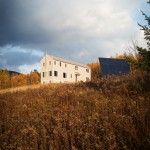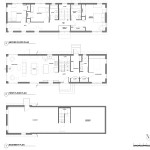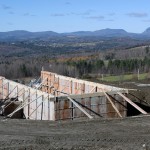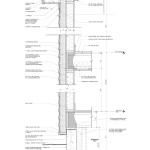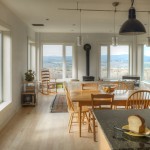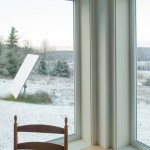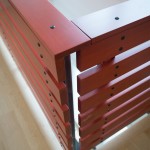Net Zero Family Home
Project Name
This 2,400 SF four-bedroom house, located on a 15-acre sloping site in Vermont’s Northeast Kingdom, was designed for a growing family on a tight budget. The house sits high on the hill, improving views and leaving majority of the land available for growing hay. Willoughby Gap dominates the panoramic view, enjoyed from main living areas.
A simple building form and structural system address budget constraints. The narrow plan eliminates interior columns. Except for the minimal disruption of the stair, joists and roof trusses span the width and march down the length of the house. The economical gable form is a reinterpretation of local vernacular buildings.
The house has three bedrooms and two bathrooms on the second floor. The smal size of the children’s bedrooms is offset by the wider connecting play/study hall (with it’s own view of the valley). On the main level, kitchen, dining, and living are combined; beyond the stair is a study/bedroom with a possible en-suite configuration. A studio and a play/exercise area occupy the above-grade end of the basement.
Two air-source heat pumps, (in basement and on main level), heat the house. A small wood stove provides backup heat. Floor grates, salvaged from a renovation project, allow heat to move up to the second floor. All the bedrooms have provision for installing radiant ceiling panels for supplemental heat, though these have not yet been necessary. An HRV provides balanced ventilation. A heat pump water heater supplies domestic hot water.
Designed interior and exterior features are being implemented as time and budget allow. Salvaged stone and steel steps at the front and back doors provide exterior access to the main level. A custom wood railing protects the second floor opening above the front door.
METRICS:
The design model predicted an annual energy demand of 7,996 kWh/year or 27,283,487 BTU/year. This is 11,368 BTU/SF/year.
Utility invoices were used to track electricity consumption and PV generation. Extrapolated to twelve months, and adding the energy from one cord of wood, annual energy demand is 9,849 kWh/year, 33,604,788 BTU/year, or 14,002 BTU/SF/year. Solar PV production fell short of net zero by 790 kWh over the year, or 2,695,480 BTU/year.
Architecture or A/E Firm Name
Architect
Team
Location
Client
General Contractor
MEASURE 1: DESIGN & INNOVATION
Air-source heat pumps are not commonly used in northern Vermont, but a number of projects, including this one, are testing and proving the feasibility of using the technology in this cold and windy location. The key is a carefully designed and constructed high performance envelope. Careful location of windows and long interior views make the house feel larger than it is.
MEASURE 2: REGIONAL COMMUNITY DESIGN
The design reinterprets New England vernacular and blends green elements and durable materials into a contemporary, yet timeless aesthetic.
MEASURE 3: LAND USE & SITE ECOLOGY
The building’s location on the site preserves the agricultural character of the landscape. A local farmer uses the field to grow hay.
MEASURE 4: BIOCLIMATIC DESIGN
The house was sited and designed to maximize views, cross-ventilation, and opportunities for natural light. Locating it near the trees at the northeast corner of the property provides some shelter from winter storms. The long façade of the house faces fifteen to twenty degrees west of true south, close enough so that there is appreciable passive solar gain in the winter. Ground water is relatively close to the surface and flows down the hill, so the house is very narrow across the slope to minimize water pressure on the basement walls.
MEASURE 5: LIGHT & AIR
All habitable rooms have ample day-lighting and cross-ventilation. There is less glazing on the north elevation to reduce heat loss. The house has a ducted energy recovery ventilation system.
MEASURE 6: WATER CYCLE
Water efficient fixtures are used throughout. Water is supplied by a well.
MEASURE 7: ENERGY FLOWS & ENERGY FUTURE
The envelope is super-insulated (basement slab at R-20; basement walls at R-28; above grade walls at R-46; roof at R-95 (averaged); triple-glazed windows at R-8) with very high levels of air tightness (0.4 ACH as measured by a blower door test). The four inches of exterior foam all but eliminate thermal bridging. The tracking solar collector has a capacity of 8 KW. Both the house and garage roofs are available for additional fixed solar panels. The site is high and very exposed, so wind power may be a viable option.
MEASURE 8: MATERIALS & CONSTRUCTION
Exterior walls were tested for air tightness with a fog machine. All exterior materials are low maintenance. No- or low-VOC materials are used throughout the interior.
MEASURE 9: LONG TERM FLEXIBILITY AND ADAPTABILITY
The study/guest bedroom on the first floor is large enough to work as a future master bedroom. Pocket doors allow the adjacent bathroom and hall closet to create a workable master bedroom suite. This extends the possibilities for aging-in-place.
MEASURE 10: COLLECTIVE WISDOM & FEEDBACK LOOPS
Overall energy use and generation is tracked using utility invoices, the internet connection to the PV collector, and an eMonitor. While the utility invoices give a general picture of energy use, the eMonitor is providing the detailed data needed to commission systems and inspire efficient use of energy. The data also showed that one air-source heat pump was short-cycling, compromising its effectiveness and efficiency. Repairs have been made, and it is hoped that the energy performance of the house will improve noticeably.

